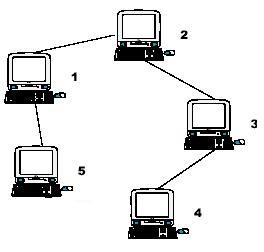Computer
Time Limit: 1000/1000 MS (Java/Others) Memory Limit: 32768/32768 K (Java/Others)
Total Submission(s): 5670 Accepted Submission(s): 2834
Problem Description
A school bought the first computer some time ago(so this computer's id is 1). During the recent years the school bought N-1 new computers. Each new computer was connected to one of settled earlier. Managers of school are anxious about slow functioning of the net and want to know the maximum distance Si for which i-th computer needs to send signal (i.e. length of cable to the most distant computer). You need to provide this information.

Hint: the example input is corresponding to this graph. And from the graph, you can see that the computer 4 is farthest one from 1, so S1 = 3. Computer 4 and 5 are the farthest ones from 2, so S2 = 2. Computer 5 is the farthest one from 3, so S3 = 3. we also get S4 = 4, S5 = 4.

Hint: the example input is corresponding to this graph. And from the graph, you can see that the computer 4 is farthest one from 1, so S1 = 3. Computer 4 and 5 are the farthest ones from 2, so S2 = 2. Computer 5 is the farthest one from 3, so S3 = 3. we also get S4 = 4, S5 = 4.
Input
Input file contains multiple test cases.In each case there is natural number N (N<=10000) in the first line, followed by (N-1) lines with descriptions of computers. i-th line contains two natural numbers - number of computer, to which i-th computer is connected and length of cable used for connection. Total length of cable does not exceed 10^9. Numbers in lines of input are separated by a space.
Output
For each case output N lines. i-th line must contain number Si for i-th computer (1<=i<=N).
Sample Input
5 1 1 2 1 3 1 1 1
Sample Output
3 2 3 4 4
Author
scnu
Recommend
#include <cstdio>
#include <cstring>
#include <queue>
#include <algorithm>
#define G 100000+10
using namespace std;
struct Edge
{
int from, to, val, next;
};
Edge edge[G*2];
int head[G], edgenum;
int dist[G];
bool vis[G];
int N;
int S, T;//最长路两个端点
int d1[G], d2[G];//分别存储最长路两个端点到该点的距离
void init()
{
edgenum = 0;
memset(head, -1, sizeof(head));
}
void addEdge(int u, int v, int w)
{
Edge E = {u, v, w, head[u]};
edge[edgenum] = E;
head[u] = edgenum++;
}
int BFS(int sx)
{
queue<int> Q;
memset(dist, 0, sizeof(dist));
memset(vis, false, sizeof(vis));
vis[sx] = true;
int ans = 0;
int node = sx;
Q.push(sx);
while(!Q.empty())
{
int u = Q.front();
Q.pop();
for(int i = head[u]; i != -1; i = edge[i].next)
{
Edge E = edge[i];
if(!vis[E.to] && dist[E.to] < dist[u] + E.val)
{
dist[E.to] = dist[u] + E.val;
if(dist[E.to] > ans)
{
ans = dist[E.to];
node = E.to;
}
Q.push(E.to);
vis[E.to] = true;
}
}
}
return node;
}
int main()
{
while(scanf("%d", &N) != EOF)
{
init();
int a, b;
for(int i = 2; i <= N; i++)
{
scanf("%d%d", &a, &b);
addEdge(i, a, b);
addEdge(a, i, b);
}
S = BFS(1);//找到一个端点
T = BFS(S);//以找到的端点为起点 找另一个端点
for(int i = 1; i <= N; i++)
d1[i] = dist[i];//S为起点 到各点的最长路
BFS(T);//以另一个端点为起点
for(int i = 1; i <= N; i++)
{
d2[i] = dist[i];//T为起点 到各点的最长路
printf("%d\n", max(d1[i], d2[i]));
}
}
return 0;
}























 被折叠的 条评论
为什么被折叠?
被折叠的 条评论
为什么被折叠?








